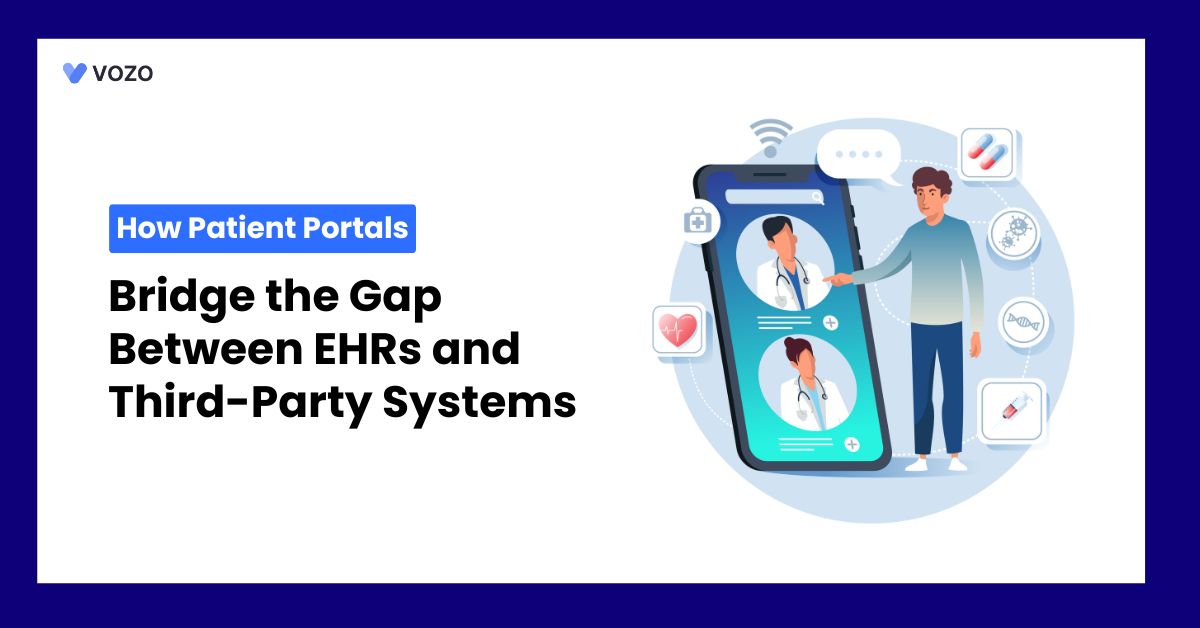How Patient Portals Bridge the Gap Between EHRs and Third-Party Systems
Sharing information between healthcare systems is often a big challenge. EHRs store patient data, but they don’t always integrate with other platforms. For instance, billing systems, telehealth services, and pharmacies need seamless data access.
That’s where patient portals step in. These secure platforms help important information flow smoothly between different systems.
As a result, healthcare providers can access records faster and provide better care. In this blog post, we have shared how patient portal platforms bridge the gap between EHRs and other third-party systems.
The Challenges of Disconnected EHRs and Third-Party Systems
Healthcare systems must work together to keep patient records accurate.
However, when EHRs do not connect, serious challenges might arise for providers. This lack of connection causes confusion and inefficiencies in daily operations.
- One major issue is scattered data across multiple platforms and systems. Without proper connection, important details stay scattered in different systems.
- Another challenge is slow workflows that waste time and energy. Healthcare staff switch between platforms, making routine tasks longer and harder.
- Disconnected systems also create compliance risks for audits and legal regulations. If patient data is inconsistent, reports may contain serious errors.
- For patients, disconnected systems mean repeating information at every visit. This can be frustrating, leading to a poor experience during care.
How Patient Portals Act as a Bridge Between EHRs and Third-Party Systems
1. Centralized Access to Health Data
A patient portal stores health information in one secure digital place. By integrating with multiple healthcare platforms including:
- Laboratory Management System
- Pharmacy System
- Remote Monitoring Tools
Patient portals ensure that all essential health information is accessible from one place. This allows patients to check records, prescriptions, and lab results easily. Instead of switching to another system, they find everything in one centralized place to access the data.
For providers, centralized data reduces paperwork and streamlines daily tasks.
It helps prevent errors by keeping records updated and well-organized. With better access, healthcare providers can make faster and more informed medical decisions.
Related: How Patient Portals Enhance Access to Your Health Records
2. Seamless Integration with Telehealth, Billing, and Wearable Devices
A patient portal platform seamlessly integrates with a telehealth platform, billing system, and wearable devices.
- Patients can easily join telehealth consultations within the platform. No need to switch up to a telehealth platform. Healthcare providers can access medical records during telehealth appointments for better care. This connection makes remote healthcare more convenient and effective.
- For billing, patient portals help simplify payments and insurance processing. Patients can view bills, check coverage, and make payments in one place. This reduces confusion and makes managing healthcare costs easier. Clear billing access improves transparency and enhances the patient experience.
- Wearable devices sync with portals to share real-time health data. Healthcare providers can monitor vitals like heart rate, blood pressure, and activity levels. This helps detect health issues early and adjust treatments as needed.
By linking all these systems, patient portals create a more connected healthcare experience.
Related: The Ultimate Guide to Optimizing Patient Portals for Increasing Payment Collection
3. Enhancing Provider Collaboration
A patient portal helps healthcare providers, nurses, and specialists to share patient information easily. It integrates with different systems so medical data flows without any delays. This ensures all providers see the same updated patient health records. With shared details, they can make faster and more accurate decisions.
When several healthcare providers treat a patient, good coordination becomes important. A portal helps them track treatments, medications, and test results quickly.
This reduces miscommunication and prevents repeated tests or unnecessary medical procedures. As a result, patients receive safer, better, and more effective care.
Real-time updates keep providers aware of a patient’s changing needs. Healthcare professionals can send messages, request advice, and review reports right away. This improves coordination and makes treatment more personal and efficient.
4. Improve Patient Engagement
A patient portal encourages patients to be involved in their care. It provides easy access to records, test results, and prescription details.
With this information, they have a better understanding of their health and make smart choices. This also improves discussions between patients and their healthcare providers daily. Patients can use portals to schedule provider visits, request medication refills, and send messages to healthcare providers for health clarifications.
Quick access to care makes health management easier and less stressful. As a result, patients feel more confident about their overall well-being. Patient portals have various capabilities such as Reminders for medications, check-ups, and follow-ups to keep patients on track.
They receive alerts about important health tasks and upcoming doctor visits. This encourages them to follow treatments and avoid missing necessary care. By staying engaged, patients build better habits and improve long-term health.
Vozo Patient Portal for Better Health Management
Vozo patient portal software has incredibly empowered patients with advanced & simplified portal features. This includes secure one-to-one messaging and easy appointment scheduling.
It also provides easy access to lab reports and record consultations. Requesting and refilling e-prescriptions are way too simple now.
Your Problems:
- Integration or implementation issues?
- Doubting the support system?
- Looking for a portal under your budget?
- Switching or upgrading to the Vozo patient portal?
- Finding troubles with usage or functions?
- Are you facing an issue with getting patients to opt in?
- Security concerns?
- Need a customized portal for your specialty?
Our Solutions:
- Our software can be easily implemented & integrated with any EHR system. It improves practice workflow and productivity.
- Our team of professionals is readily available 24/7 to get things done for you, no matter what your practice size.
- Vozo patient portal fits your budget perfectly with monthly subscription plans.
- Switching to our portal is a straightforward process; you won’t need any help, yet our team has your back.
- We provide various step-by-step tutorials and help to get you on track with the portal.
- Our portal is simple to use and understandable to all. Once they get to try this, there will be no turning back.
- Our portal has strong privacy and security safeguards in place.
- Vozo Patient Portal can be exclusively customized to satisfy your specific specialty requirements and workflow.
“Let’s empower your patients with the best cost-effective patient portal together”
About the author

With more than 4 years of experience in the dynamic healthcare technology landscape, Sid specializes in crafting compelling content on topics including EHR/EMR, patient portals, healthcare automation, remote patient monitoring, and health information exchange. His expertise lies in translating cutting-edge innovations and intricate topics into engaging narratives that resonate with diverse audiences.













